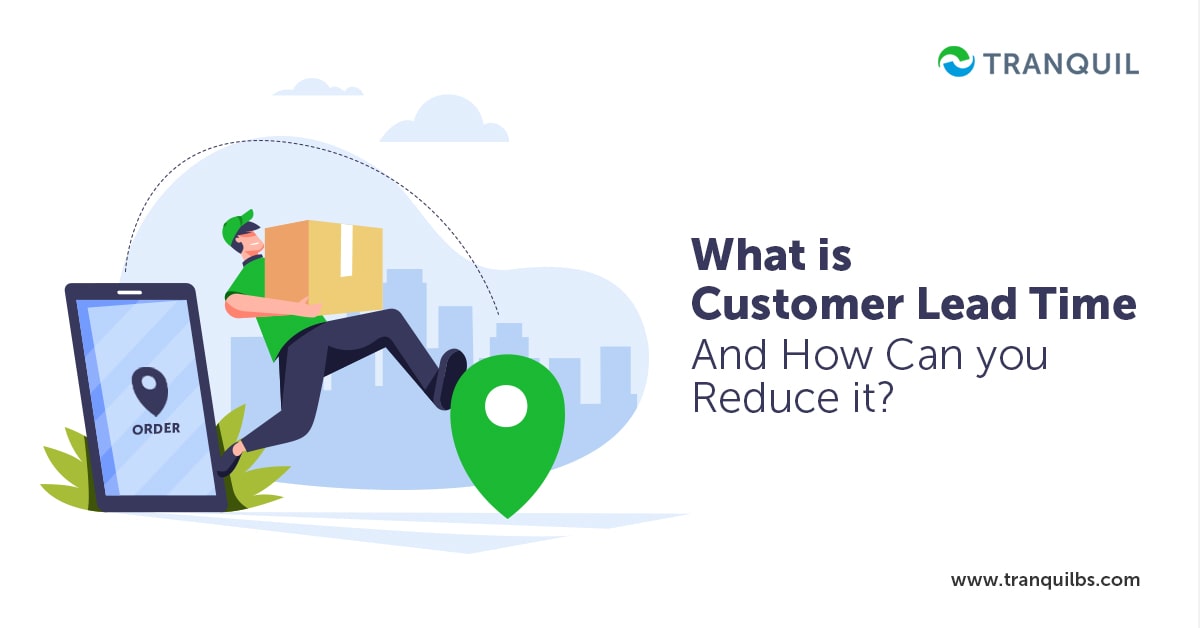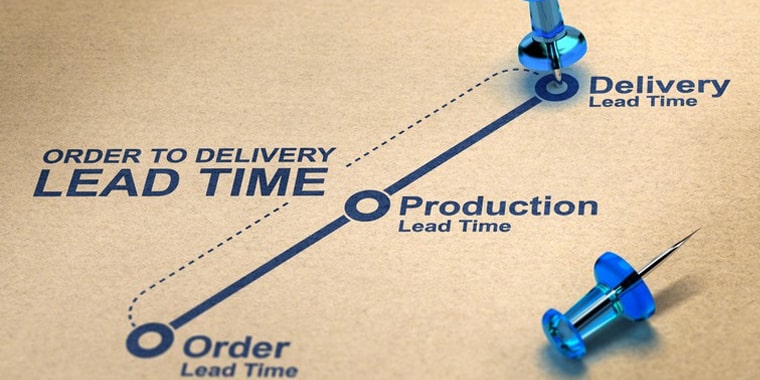
While online shopping is nothing new, during the global lockdowns during the Covid-19 pandemic, this trend grew exponentially.
It was safer and more convenient to buy online.
This transformation in retail buying has also transformed how businesses operate. Companies today have to fulfil customer demands, ensure prompt delivery, and generally deliver excellent service – or else, they will simply move to the next company.
Businesses have to manage their inventory and supply chain efficiency to be able to satisfy consumer demands; eCommerce fulfillment basically means delivering the correct quantity and quality of products on the promised date. If you are not able to, you will stand to lose customers.
ALSO READ: What is Inventory Reorder Point?
The time taken for a product to reach the customer from the time they place the order is called the lead time.
Every business must strive to shorten this time as much as possible so that they can create great customer experiences and satisfy their demands.
The longer the lead time, the more money and resources you use, and the more inefficient your business becomes.
This is simply reducing the time taken for delivering a customer’s order from the time they place the order.
Lead time management is all about improving the flow so that the entire process becomes smooth.
This means every process from procurement through sales to shipping has to be seamless, quick, and hassle-free so that you minimize the time taken from start to finish.
Both manufacturers and retailers are today taking steps to enhance consumer access to a wider array of goods and decrease expenses.
ALSO READ: Why is Cycle Stock Important for Your Business?
Implementing a lead time reduction strategy will help you understand and manage your supply chain better, and be well-equipped to alleviate risks and improve your financial performance.
In fact, once the lead time is reduced, your risk will be negligible, and the supply chain will deliver better customer service.
Your company will be able to fulfil consumer demand and increase profitability, helping you accelerate your growth beyond what you thought possible even.
The chief objective of lead time reduction is delivering the right product to the customer at the right time and right price.
For this, you need to constantly monitor and assess multiple parameters of operations and simultaneously attempt to increase efficiencies.
ALSO READ: Common Inventory Management Mistakes to Avoid

Lead time in inventory and supply chain can lead to delayed deliveries and unhappy customers.
Let’s look at the advantages of decreasing the lead time.
With automation in your processes, you can reduce lead time without spending much.
There are customizable solutions available, which help you save money while fulfilling production goals.
You can score over your competition by being the first to market.
ALSO READ: What is Pipeline Inventory and Decoupling Inventory?
By making improvements in supply chain, logistics, and inventory management, you can become more reliable, deliver products to customers quicker and build trust.
This will also help you to avoid stock-outs, and make use of all sales opportunities and gain new customers.
When you reduce the time taken to deliver a product to the consumer from the time you receive it from your vendor, it significantly improves your cash flows.
Inventory turnover refers to the number of times your inventory is sold and replaced; a high turnover means you have good sales.
Reducing lead times can lead to more orders and sales, which means your products get sold faster; this way you can avoid obsolete and dead stock.
ALSO READ: Key Steps for Successful Demand Planning
Process time also focuses on time, but worked on by an individual working on a specific task, and includes waiting and walking time.
Strategies that look at minimizing process time ignore many activities in the entire supply chain.
Whereas lead time is the time required from the time a customer’s order is accepted and processed through the supply chain, through production to shipping.

Decreasing lead time in supply chain can help you reduce customer lead time as well.
It is important to understand your supply chain well as it will help in identifying areas of improvement, especially for visibility and control.
By implementing a state-of-the-art supply chain, you can get a virtual picture about it and processing times for each section, helping you see where you can improve things and gain an edge.
ALSO READ: Advantages of ABC Analysis in Inventory Management
This includes waiting for information to take any action, conducting nonessential meetings, holding high inventory, moving safety stocks, and other unnecessary activities.
With proper planning, you can ship and deliver customer orders quickly and consistently.
Tranquil ERP has robust inventory management software that helps in managing your inventory efficiently and reduce costs, making products available quickly so that you can focus on increasing revenues.
If any vendor consistently delivers your orders late, it may be time to say goodbye to them.
They may cost you more than finding another supplier.
Evaluating your vendors will have a positive effect on your financial performance even if you consider the transition cost.
Just make sure that you have enough stock to last you in the transition period, and that your new vendor can start delivering goods immediately.
ALSO READ: Ways to Improve the Procurement Process

The marketplace is global today, giving you access to suppliers the world over; however, you may have to wait for a long time to get deliveries, increasing your lead time, and complicating the process of returns.
It would make sense to prioritize vendors who are near your manufacturing unit or warehouses.
If it’s a matter of price and/or quality, order from your overseas in larger quantities but less frequently.
Sourcing locally can help you reduce lead time and save in shipping cost; so you can order when you’re running out and your overseas shipment still has time to arrive.
Businesses in industries with fluctuating demands can experience varying demands every month.
So, when you’re expecting higher demand, it’s a good idea to inform your suppliers early on so that they are prepared to fulfil a larger order quickly.
ALSO READ: Tips For Efficient Stocktaking
If you outsource some of your processes, think about handling that in-house so that you can stop sending your products to third parties for finishing.
While it may cost you initially, you will save in the long run, and cut down lead time significantly and for good, making it a feasible option.
This will also form your infrastructure for future growth. You will be able to scale easily as your business grows, and you earn more profit.

When you’ve got the raw materials and are about to start manufacturing, ensure that internal processes are efficient so that production lead time is decreased.
Think about how long you need to enter customer orders in your system, how often orders get lost, the time taken to produce goods and move them through QA, and how many times poor communication causes delays in production.
In case your performance in one or more of these areas isn’t good, you’re likely to have lengthy lead times.
Order processing workflow automation can help you roll out finished goods faster.
Automation includes robotics, barcodes, RFIDs, and strategies that reduce human effort in operations.
ALSO READ: Challenges in ERP Implementation
Certain processes are dependent on others being completed to start, and there is nothing you can do about that.
However, many are independent of one another; identify such processes and run them simultaneously to boost productivity and cut down lead times more.
Order processing involves multiple departments, and hence collaboration is essential.
To collaborate, it’s a given that proper communication is necessary.
Certain steps may necessitate inputs from several employees from different departments, and it is critical that there is no confusion.
Also, it is better to avoid using paper for these processes and switch to a software system like Tranquil which automatically routes documents to the relevant employee or department in order of priority, and alerts those individuals about taking action on specific documents.
ALSO READ: What is Batch Tracking?
While this does not actually help you decrease lead time as such, you can keep customers informed regarding their order status; this will help them stay loyal and prepare them to wait, as they are aware of what is happening with their order.
You can implement Tranquil ERP which will help you do this automatically.
This way you can set customer expectations and boost satisfaction.
Even little changes made to your shipping methodology can give you better control over delivery schedules and help decrease expenses.
Explore the shipping methods available to your for the type of products you have and work out which methods will be quicker and more economical.
ALSO READ: Critical Factors for a Successful ERP Implementation
This strategy is used by businesses to make up for the time that is lost in shipping goods.
The company produces its raw materials and components, rather than purchase them; this can significantly reduce lead times.
Of course, it will necessitate heavy financial investment at the outset, but in the long run, it will help save money on overheads, reduce time, and help to scale the business.
ALSO READ: Important ERP Implementation KPIs to Know
Obstacles to flow include batch-oriented machines, lengthy configuration times, long distances, poor maintenance, and so on.
This can be improved with layout planning.
This has several steps, from how you organize data to how you can avoid supply chain conflicts.
Lean layouts often focus on minor and unimportant things like waste management and decreasing changeover time, but layout planning concerns itself with the overall picture, like the way your facility is organized, where the waste is, and how the whole organization can be redesigned to align with just-in-time and flow concepts.
Having a visual representation of this layout will benefit all stakeholders.
ALSO READ: ERP Software to Enhance your Purchase Management

Now this can be a little difficult especially when you are doing it on an operational level, as the lead time can differ according to the department, and operation in your company.
It is important to identify which department or operation has the longest lead time.
This can be established with an effective quality assurance audit or a thorough root cause analysis; you can also do it visually.
A graphical mapping tool like 3D visualization, spaghetti diagrams, or value stream analysis will help the participants to recognize wastage, and ideas to improve things.
They will be able to understand how much time it takes from the time a customer order is received till it is delivered to their doorstep.
The results of this study can be used as a basis to take remedial measures and to report to the management regarding the measures taken to improve lead time over time.
ALSO READ: Guide on How Do ERP Systems Work
Tranquil is a prominent cloud-based ERP software system that helps you to manage your projects and business work in a hassle-free way. Moreover, with this software, you can access your business data anywhere, any time. If you want to manage an ERP software system, you can get in touch with Tranquil BS.